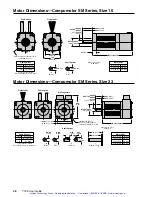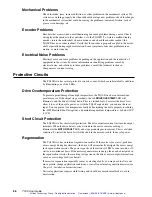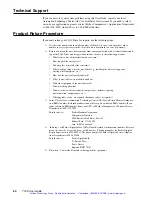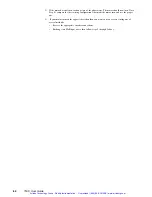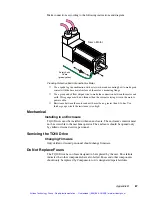
➃
Troubleshooting
5 5
Non-Drive Related Problems
When the drive is powered up, enabled, and operating properly:
•
The
POWER ON
LED is illuminated green
•
No LEDs are illuminated red
•
The fault output is LOW
These conditions indicate that the TQ10 is probably not the source of the problem. The
next table summarizes other possible sources of problems.
TROUBLESHOOTING TABLE
SOLUTION
CONTROLLER/
INDEXER
MOTOR
MECHANICAL
SYSTEM
WIRING
OVERHEATING
AC POWER
MOVE PROBLEMS
ELECTRICAL NOISE
Cycle power to clear fault latch.
Verify step/direction pulses at TQ10SD step/direction inputs.
Verify control voltage at TQ10 Torque Drive command input.
Check for motor problems. Check motor coils for continuity,
shorts, proper resistance. Check Hall and Phase wiring.
Check for jams, binds, increased friction, etc.
Uncouple motor from load to test motor separately.
Check motor wiring: phases, Hall effects.
Check controller/indexer wiring, especially enable.
Verify that drive's heatplate has good thermal contact with
Verify AC power mains supply delivers enough power during
entire move without undervoltage, especially during acceleration.
Check speed/torque limitations. Check for excessive friction,
regeneration, problems with gravity, transient undervoltage, etc.
Check for problems caused by electrical noise. Consult the
heatsink. Check mounting screws. Provide sufficient ventilation.
Compumotor sales guide for possible solutions. Check grounds.
Possible Source
of Problem
Problems During Move
Some problems occur transiently during a move, or do not affect the LEDs. Others may be
due to wiring mistakes, or failure of other components in the system (controller or indexer,
encoder, motor, etc.). The sections below will help you identify such problems.
Speed/Torque Limitations
Make sure that you are not commanding a move that requires the motor to go faster than it
can, or use more torque than it can produce. Check the motor’s speed/torque curve for your
operating conditions.
Acceleration
Some problems during acceleration can be caused by an undervoltage on the AC power line
(this can be a transient event), an unrealistic move profile, or too much load inertia.
Deceleration
Some problems during deceleration can be caused by excessive regeneration, resulting in an
overvoltage fault.
Excessive Friction
Too much friction in your system might cause move problems. Excessive friction can cause
trouble when mechanical components in a system age. As friction increases, problems may
occur in a system that had previously been working well.
Artisan Technology Group - Quality Instrumentation ... Guaranteed | (888) 88-SOURCE | www.artisantg.com








